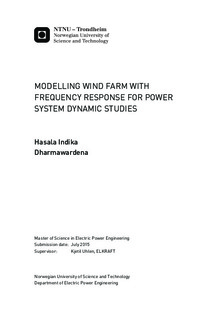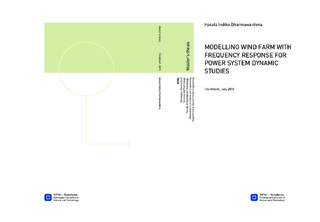| dc.description.abstract | This dissertation presents an analytical study on modelling wind farm with frequency response
for power system dynamic studies. Recent trends indicate that wind energy penetration in the
power system will keep on increasing. This study models a permanent magnet synchronous
generator fully rated converter based wind farm, since this is one of the state of art technologies
that services this growing demand. Due to the variability in the wind resource, a high demand
will be placed on the frequency stability of the power system. This necessitates the requirement
of providing both inertial and governor support by the wind farm to the power system. High
wind penetration will have a significant impact on the power system stability. These impacts
needs to be investigated by conducting power system dynamic studies.
The main challenge is in identifying an appropriate level of complexity of the models to
represent power system electro-mechanical dynamics, while keeping the models as simple as
possible, to reduce the computational requirements. Taking this into consideration, the main
contribution of the modelling work, is identifying a full order model and a reduced order model
of a wind farm with frequency response. The dissertation presents the dynamic models of the
main components of a wind turbine and shows how the component models are combined to
generate a full order and reduced order model.
The wind farm is interfaced to the utility grid by a back to back voltage source converter.
Therefore selection of robust control structures and identification of control parameters constitutes
an important study element. Both, generator converter controller and grid converter controller
is given special attention. Auxiliary control loop for implementing frequency response is
identified and integrated to the models.
The power system under study is the Kundur s two area network. One synchronous generator
is substituted by the wind farm and contributes to 25% of the system capacity. The dynamic
system study investigates aspects of both frequency and small signal response.
The full order and reduced order model dynamic response, for a variable wind speed sequence,
shows a high degree of correspondence, both with and without frequency control. Therefore
the results of this work indicate that a reduced order model is sufficient to model power
system electro-mechanical dynamics without significant loss in accuracy. The full order and reduced order model small signal response, for constant wind speed and
without frequency control shows a high degree of correspondence. However the full order and
reduced order model response shows deviation, when the wind farm is supported with frequency
control. Therefore the full order model provides a more accurate small signal response
for wind farms with frequency control. The studied network reveals a poorly damped inter area
mode. Substitution of a synchronous generator by the wind farm, increases the damping of this
mode, decreasing inter area oscillations and enhancing system small signal stability.
The simulations of an over frequency event, in a system with a wind farm supporting frequency
control, clearly shows superior frequency response, in comparison to a wind farm without
frequency control. The salient performance is reflected in rate of change of frequency, temporary
maximum frequency, steady state frequency and settling time of the frequency response. | |

